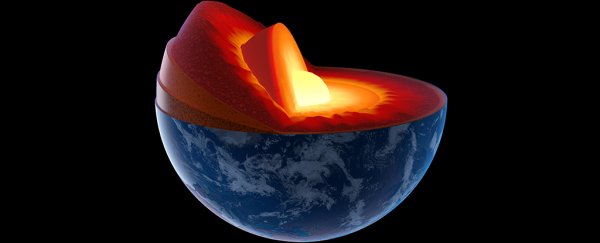New research has revealed a previously unknown source of magnetism deep within our planet's stupidly hot, squishy layers. Far from being magnetically dead, some of Earth's mantle might have pockets of iron oxide (Fe2O3) with enough magnetic pull to have a real effect.
A research team made up of scientists from around the globe has provided evidence that the mineral hematite retains its magnetic properties even when squeezed under mountains of rock and heated to just under 1,000 degrees Celsius.
"This new knowledge about Earth's mantle and the strongly magnetic region in the western Pacific could throw new light on any observations of Earth's magnetic field," says mineral physicist Ilya Kupenko from the University of Münster in Germany.
For the most part, the giant cage of magnetic field lines that deflects potentially harmful radiation from our planet's surface is the result of our liquid iron core on spin cycle.
This dynamo effect is why our planet has a magnetic field and Mars doesn't. (No offence, Mars.) Our core is still turning after all these years, while our red neighbour's heart has grown cold and still.
Minerals locked in the solid crust of both worlds hold onto the ghostly imprint of this dynamo, resulting in a second source of magnetic influence we can detect from orbit.
While similar minerals are plentiful deep underfoot, the distortions caused by immense heat and pressure should eventually erase that imprint past a critical point the further down you go. That's the theory, at least.
But testing this for specific materials under extreme conditions is easier said than done.
With the poles of our planet's magnetic field skipping and jumping around in ways we're struggling to predict, getting a grip on how potentially magnetic materials in our mantle really behave is looking more important than ever.
To meet the technical challenges involved in investigating the forms hematite takes at serious depths, the researchers combined something called Mössbauer spectroscopy with laser heating in a diamond anvil.
It allowed them to cook a sample of hematite to somewhere between 300 and 1,300 degrees Kelvin (26 to 1,026 Celsius, or 80 to 1,880 Fahrenheit), while squeezing it to 90 gigapascals, or nearly 90,000 times the weight of our atmosphere.
Gamma rays were then used to analyse the precise positions of the particles making up the sample, allowing the researchers to calibrate temperatures with enough precision to determine magnetic transitions between different phases.
While the mineral's magnetic properties did vanish in the long run, they remained detectable below 1,200 degrees Kelvin.
That still rules out most of the mantle, which typically varies from about 1,000 to a sizzling 3,000 degrees Kelvin. But it's a close call, hinting that pockets of hematite up to a few hundred kilometres below the surface could be magnetically active.
"As a result, we are able to demonstrate that Earth's mantle is not nearly as magnetically 'dead' as has so far been assumed," says mineralogist Carmen Sanchez-Valle from the University of Münster.
"These findings might justify other conclusions relating to Earth's entire magnetic field."
For example, this discovery could help us understand why intense areas of the field are drifting faster than our models can explain, prompting a premature update to a particular type of map we use to navigate our way around the globe.
Hematite in subducted slabs to the north-west of the Pacific could be affecting how we keep track of magnetic movements.
"What we now know – that there are magnetically ordered materials down there in Earth's mantle – should be taken into account in any future analysis of Earth's magnetic field and of the movement of the poles," says geochemist Leonid Dubrovinsky from Bayreuth University in Germany.
Last year, the European Space Agency's Swarm mission detected a faint signal of magnetism arising from the swirl of dissolved ions in our planet's oceans.
While subtle effects like these might seem trivial, we rely heavily on the magnetic field to shield technology on our surface from the effects of extreme solar activity. It's important we learn all we can about that protective cage over our heads.
This research was published in Nature.
